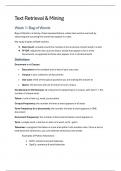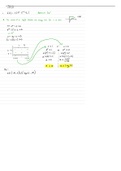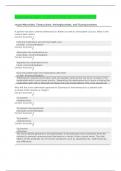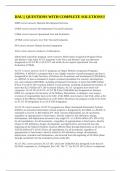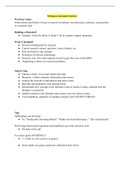Cognitive neuroscience lectures
Lecture 1: introduction & EEG methods
History of neuroscience:
- Franz Joseph Gall suggested that surface of the head depends on mental skills. > phrenology
Modern neuroscience:
- Is cognitive neuroscience not the same as modern phrenology?
o Yes functional differentiation of the brain.
o No functions are defined by thorough experimentation; multidisciplinary research; not
just about the size of brain areas, but also measure anatomy and structure, measure
effects of brain damage, measure development of areas & networks, measure neural
activity, measure chemical elements in the brain, model/simulate brain processes.
Anatomy and structure:
- Many different types of cells, connections, and neurotransmitter
- Brodmann was the first to map the cortex based on cell types
- Each neuron type has a different function
Neurons:
- Different from normal cells:
o Axon & dendrites are specialized structures to transmit and receive information through
action potentials.
o They tend not to reproduce after birth
o Connections do alter
o Each cell type has its own specialized function
,Damage to anatomy (clinical neuropsychology):
- Stroke:
o Hemorrhagi stroke: blood leaks into
brain tissue
o Ischemic: clot stops blood supply to
an area of the brain
- Tumors or infections
- Neural degeneration
- Trauma
- Epilepsy & lesions
- Genetic manifestations
Measuring brain activity:
- Action potentials (electrophysiology)
- Local field potentials (electrophysiology)
- Electromagnetic field at scalp (EEG/MEG)
- Manipulating neural activity (TMS/tDCS)
- Blood oxygenation (fMRI; PET; fNIRS)
Brain elements:
- Pharmacology
- Food supplements
Brain computation:
- Making models of the brain to improve
applications
ElectroEncephaloGraphy:
, - Electro = electromagnetic fields
- Encephalo = related to the brain
- Graphy = descriptive science
What does it measure?
- Differences in voltage across the scalp
- Reflects post-synaptic potentials: difference in voltage along axons
- Both inhibitory and excitatory
- Reflects local field potential not single action potentials but a summation of many neurons
When is the measurement good?
- Mass activity: many neurons with the same alignment
- Synchronized activity: not individual action potentials
- Close to the scalp: scalp & skull is not a good conductor smears out the signal
- No noise sources: electronic devices artefacts in the data
- Electrode layouts:
o 32-64 electrodes = enough for P100, N200, etc
o 128 electrodes = enough for localization
Advantages
- EEG voltage potentials
o Measures brain states and temporal characteristics of brain processes
o Most sensitive to activity in fyri
- MEG magnetic field
o Similar measure, but better localization and most sensitive to activity originating from
sulci
- EEG = relative cheap, measures more neurons
- MEG = expensive, better localization
When to use EEG?: when you are interested in brain states or effects over time at a high resolution. In
some cases useful for the localization of neural loci.
Brain waves & arousal:
- Fast waves (beta/gamma) = high arousal
- Slow waves (alpha/theta/delta) = low arousal
- Gamma (32Hz>) = superlearning
, - Beta (16-31 Hz) = processing information, analytical thinking
- Alpha (8-15 Hz) = eyes closed or very relaxed
- Theta (4-7 Hz) = sleep, REM, dreaming, deep meditation
- Delta (<4 Hz) = deep dreamless sleep
Theta/beta ratio:
- Lower ratio = more arousal
- Higher ratio = less arousal
- ADHD patients: increased theta/beta ratio higher theta
Applying EEG waves:
- ADHD hyperactive, but less cortical arousal
- Treating ADHD: increase arousal with medicine
- Counterintuitive: give stimulant to hyperactive children
Event-related potentials:
- On top of background EEG waves
- Many trials to get noise-free average of ERP
- Peaks and troughs
By measuring amplitudes & latencies of peaks and troughs: amount & timing of activity
Inverse problem:
- Numerous models possible to explain scalp distribution
- Limit possibilities by assuming minimal amount of dipoles
- Solutions: combine with fMRI; combine with EEG & MEG
EEG as a Brain Computer Interface:
- When size (amplitude), timing (latency) and location for a specific action, thought or cognitive
function are known
- Solutions by BCI:
o Improve functions
o Replace functions
Lecture 2 functional MRI & the visual system
Both structural and functional MRI are also very important ways to understand what changes in the brain
during disease might underlie the symptoms of the disease This helps us to understand the mechanisms
of brain diseases, sometimes revealing ways to diagnose these diseases or approaches we might take in
treatment.
What is MRI?
The tissues of the body may not seem to have obvious magnetic properties. But they react differently to
magnetic fields depending on their structure, for example the amount of wayer they contain, and this
differs between different tissues.
MRI measures the magnetic properties of tissue. It records from many points in space, allowing
Lecture 1: introduction & EEG methods
History of neuroscience:
- Franz Joseph Gall suggested that surface of the head depends on mental skills. > phrenology
Modern neuroscience:
- Is cognitive neuroscience not the same as modern phrenology?
o Yes functional differentiation of the brain.
o No functions are defined by thorough experimentation; multidisciplinary research; not
just about the size of brain areas, but also measure anatomy and structure, measure
effects of brain damage, measure development of areas & networks, measure neural
activity, measure chemical elements in the brain, model/simulate brain processes.
Anatomy and structure:
- Many different types of cells, connections, and neurotransmitter
- Brodmann was the first to map the cortex based on cell types
- Each neuron type has a different function
Neurons:
- Different from normal cells:
o Axon & dendrites are specialized structures to transmit and receive information through
action potentials.
o They tend not to reproduce after birth
o Connections do alter
o Each cell type has its own specialized function
,Damage to anatomy (clinical neuropsychology):
- Stroke:
o Hemorrhagi stroke: blood leaks into
brain tissue
o Ischemic: clot stops blood supply to
an area of the brain
- Tumors or infections
- Neural degeneration
- Trauma
- Epilepsy & lesions
- Genetic manifestations
Measuring brain activity:
- Action potentials (electrophysiology)
- Local field potentials (electrophysiology)
- Electromagnetic field at scalp (EEG/MEG)
- Manipulating neural activity (TMS/tDCS)
- Blood oxygenation (fMRI; PET; fNIRS)
Brain elements:
- Pharmacology
- Food supplements
Brain computation:
- Making models of the brain to improve
applications
ElectroEncephaloGraphy:
, - Electro = electromagnetic fields
- Encephalo = related to the brain
- Graphy = descriptive science
What does it measure?
- Differences in voltage across the scalp
- Reflects post-synaptic potentials: difference in voltage along axons
- Both inhibitory and excitatory
- Reflects local field potential not single action potentials but a summation of many neurons
When is the measurement good?
- Mass activity: many neurons with the same alignment
- Synchronized activity: not individual action potentials
- Close to the scalp: scalp & skull is not a good conductor smears out the signal
- No noise sources: electronic devices artefacts in the data
- Electrode layouts:
o 32-64 electrodes = enough for P100, N200, etc
o 128 electrodes = enough for localization
Advantages
- EEG voltage potentials
o Measures brain states and temporal characteristics of brain processes
o Most sensitive to activity in fyri
- MEG magnetic field
o Similar measure, but better localization and most sensitive to activity originating from
sulci
- EEG = relative cheap, measures more neurons
- MEG = expensive, better localization
When to use EEG?: when you are interested in brain states or effects over time at a high resolution. In
some cases useful for the localization of neural loci.
Brain waves & arousal:
- Fast waves (beta/gamma) = high arousal
- Slow waves (alpha/theta/delta) = low arousal
- Gamma (32Hz>) = superlearning
, - Beta (16-31 Hz) = processing information, analytical thinking
- Alpha (8-15 Hz) = eyes closed or very relaxed
- Theta (4-7 Hz) = sleep, REM, dreaming, deep meditation
- Delta (<4 Hz) = deep dreamless sleep
Theta/beta ratio:
- Lower ratio = more arousal
- Higher ratio = less arousal
- ADHD patients: increased theta/beta ratio higher theta
Applying EEG waves:
- ADHD hyperactive, but less cortical arousal
- Treating ADHD: increase arousal with medicine
- Counterintuitive: give stimulant to hyperactive children
Event-related potentials:
- On top of background EEG waves
- Many trials to get noise-free average of ERP
- Peaks and troughs
By measuring amplitudes & latencies of peaks and troughs: amount & timing of activity
Inverse problem:
- Numerous models possible to explain scalp distribution
- Limit possibilities by assuming minimal amount of dipoles
- Solutions: combine with fMRI; combine with EEG & MEG
EEG as a Brain Computer Interface:
- When size (amplitude), timing (latency) and location for a specific action, thought or cognitive
function are known
- Solutions by BCI:
o Improve functions
o Replace functions
Lecture 2 functional MRI & the visual system
Both structural and functional MRI are also very important ways to understand what changes in the brain
during disease might underlie the symptoms of the disease This helps us to understand the mechanisms
of brain diseases, sometimes revealing ways to diagnose these diseases or approaches we might take in
treatment.
What is MRI?
The tissues of the body may not seem to have obvious magnetic properties. But they react differently to
magnetic fields depending on their structure, for example the amount of wayer they contain, and this
differs between different tissues.
MRI measures the magnetic properties of tissue. It records from many points in space, allowing

